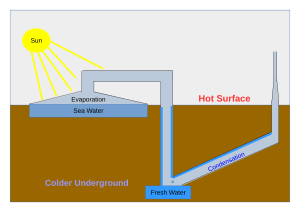This article needs additional citations for verification. (June 2021) |



A solar still distills water with substances dissolved in it by using the heat of the Sun to evaporate water so that it may be cooled and collected, thereby purifying it. They are used in areas where drinking water is unavailable, so that clean water is obtained from dirty water or from plants by exposing them to sunlight.
Still types include large scale concentrated solar stills and condensation traps. In a solar still, impure water is contained outside the collector, where it is evaporated by sunlight shining through a transparent collector. The pure water vapour condenses on the cool inside surface and drips into a tank.
Distillation replicates the way nature makes rain. The sun's energy heats water to the point of evaporation. As the water evaporates, its vapour rises, condensing into water again as it cools. This process leaves behind impurities, such as salts and heavy metals, and eliminates microbiological organisms. The result is pure (potable) water.